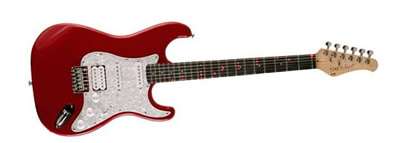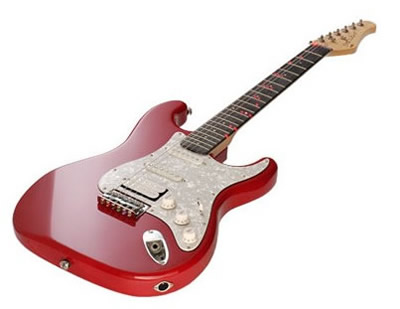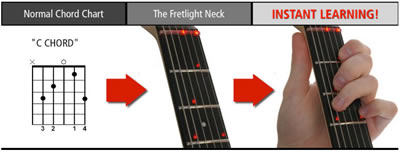|

"Teaching" guitar helps you learn without fretting excessively about itBy Jim Bray Have you ever wanted to learn the guitar but couldn't afford the lessons? Has the inability to read music stymied you? Do guitar tablatures cause your eyes to glaze like a fresh donut? Well then, friend, if any of those scenarios describes you you might find Optek's $499 Fretlight FG-421 teaching guitar to be a gift from above. This Fender Stratocaster lookalike is not only a real electric guitar, it can be interfaced with your computer to give you note by note guidance as you learn new tunes. And while I may be merely a has been hack when it comes to playing guitar in 2012, others (Guitar World Magazine, for example) think the Fretlight is pretty special product. So there. I used to play when I was much younger and, while I was never great, I could strum a reasonable rhythm guitar, as long as the tune didn't deviate too far from your typical three chord rocker. That was decades ago, however, and whatever skills I had have atrophied mightily since then. But that's why I got excited when the Fretlight folks offered me a sample to try, and thoughts of getting my immaculately callous-free hands onto such a device and using it to rocket me to the forefront of home studio practitioners began dancing through my head. Heck, maybe I could even write a few songs again! So the Fretlight folks sent me a bright red (other colors are available) "traditional electric" version of the guitar that comes with a fixed bridge (with adjustable saddles), a humbucker and two single coil pickups. It also includes tone controls, a five-position switch, and a volume knob. And, of course, its maple neck includes Fretlight's patented "Advanced Polymer" with the "world's only built-in LED learning system." That LED system is what differentiates the Fretlight from other generic "Stratocaster-compatible" axes. The LED's built into its neck illuminate under the string and on the fret in question when you're playing a particular song, showing you where and when to put your finger(s) at any particular time, the guitar getting its "fingering orders" via a DIN connector and cable that, at the other end, interfaces with your computer's USB port. What a marvelous idea! It's like having a real teacher on hand, and a far less judgmental and temperamental one than my folks signed me up with when I was a teenager. It works, too, though I had problems getting the system up and running initially. As it turned out, however, it was operator error – or at least operator assumption – that raised its ugly head. Since the guitar plugs into the computer, I assumed I could play it through the computer, using its speakers and not having to worry about an amplifer. This is not the case, however. Fortunately, I was able to borrow a Peavy amp from my son and once I had that part figured out the rest was history. Or it would have been history and full speed ahead if not for the ravages of Father Time. Yes, I must reluctantly admit that the reality of the Fretlight was somewhat different than the dream – but I can't blame the Fretlight for that! You see, the guitar works as advertised, and it works very well. What doesn't work anymore is these stubby old fingers which, while still adequate for typing (and the occasional rude gesture), no longer fly up and down a guitar's neck like they did before the years and the arthritis took their toll. It's always something… 
The Fretlight works with the Guitar Pro 6 software application that's chock full of interesting stuff, including a variety of guitar sounds and riffs, effects and stuff. As a classic rock-kind of guy, I sought out that genre immediately and was confronted by some virtual sheet music in the software's window, outlining a basic three chord rocker I remembered but whose chords I'd long since forgotten. It seemed like a good place to start. And it was. There's also the Fretlight Studio software app that includes an advanced chords and scales library as well as numerous text lessons and insight into musical theory. Fretlight's website also offers for sale a bunch of videos that show you how to play the music of such guitar legends as Eric Clapton (and if you think HIS hand is slow, you should see mine!), Bob Seger and many others. I didn't try it, but you can supposedly watch these videos right from the Fretlight Studio software and the guitar's LED's will light up in concert (no pun intended!) with your virtual mentor. I was a tad disappointed at the limited number of tunes that come with the product, but there's plenty of other stuff available for purchase and that means you can tailor the library to your tastes and/or needs. Prices range from about $3 for a single song to $80 for a complete course, which seems reasonable. Fortunately, the software lets you slow down the tempo or loop parts of a piece, which is a great way to get a handle on a particular chord, riff, or whatever. It will even let you improvise (ah, you brave souls!) with "virtually any scale over custom progressions," according to Fretlight. The manufacturer claims the Fretlight method allows players of all levels to learn "over 10 times faster than traditional methods." This, coupled with the fact you can learn quietly at home when no one else is around to laugh at you, is a real bonus. Okay, I'll admit freely that I'm not the best one to talk about the Fretlight's playability as a guitar, but I did find that it had good action and I was quite satisfied with its sound. I also found the "on neck" fingering help marvelous, despite my slowness and discomfort trying to bend my old fingers into positions they haven't tried in years. And you know, it's very cool to watch the lights flow across the neck as the robot teacher shows where your fingers should go.
Will the Fretlight make a virtuoso out of a hack? Well, I can only speak for myself and in that case the answer is a resounding "no!" But I haven't spent months and/or years dedicating myself to the process, nor have I spent long hours practicing (which is, after all, how you get to Carnegie Hall). On the other hand, I am having a lot of fun rediscovering some of my musical past. Who knows, maybe in a year or so I'll be ready to tackle something really complicated, like "Louie Louie." Copyright 2012 Jim Bray Jim Bray's columns are available through the TechnoFile Syndicate. We welcome your comments! |
|
|||
 The software is very good – the chords section, for example, gives you mouse-over click access to a picture of the illuminated LED's or the actual finger positions on the neck for a particular chord. And of course you can play something over and over again until it sinks in or your spouse objects – whichever comes first.
The software is very good – the chords section, for example, gives you mouse-over click access to a picture of the illuminated LED's or the actual finger positions on the neck for a particular chord. And of course you can play something over and over again until it sinks in or your spouse objects – whichever comes first.